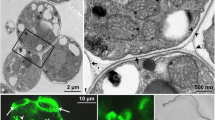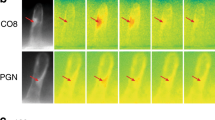Abstract
A review is presented of ongoing research on the oligosaccharide signalsinvolved in cell-cell recognition in the Chondrus crispus-Acrochaete operculata host-pathogen association. In this pathosystem,the host gametophytes are resistant to the pathogen, whereas thesporophytic generation is susceptible to infection. The virulence of thegreen algal pathogen is mediated by the recognition of carrageenanoligosaccharides released from its red algal host: kappa-carrageenanoligosaccharides inhibit A. operculata virulence while lambdacarrageenan oligosaccharides enhance its pathogenicity. It appears that therecognition of A. operculata by C. crispus also involves anoligosaccharidic signal. This signal is present in the non-virulent form of thepathogen whereas it is absent from the virulent form. Altogether thispathosystem offers a unique model to investigate the recognition ofoligosaccharide signals in plant-pathogen interactions. The possibleapplications of this research to develop new strategies for disease controlin maricultured algal crops are discussed.
Similar content being viewed by others
References
Baker B, Zambryski P, Stackawicz B, Dinesh-Kumar SP (1997) Signaling in plant-microbe interactions. Science 276: 726–733.
Baker CJ, Orlandi, EW (1995) Active oxygen in plant pathogenesis. Annu. Rev. Phytopathol. 33: 299–321.
Barbeyron, T., Michel, G., Potin P., Henrissat, B., Kloareg, B. (2000) ι-carrageeenases constitute a novel family of glycoside hydrolases, unrelated to that of κ-carrageenases. J. Biol. Chem. 275, 35499–35505.
Bouarab K, Potin P, Correa J, Kloareg B (1999) Sulfated oligosaccharides mediate the interaction between a marine red alga and its green algal pathogenic endophyte. Plant Cell 11: 1635–1650.
Correa JA, McLachlan JL (1991) Endophytic algae of Chondrus crispus (Rhodophyta). III. Host specificity. J. Phycol. 27: 448–459.
Correa JA, McLachlan JL (1992) Endophytic algae of Chondrus crispus (Rhodophyta). IV. Detrimental effects on the host following infections by Acrochaete operculata and A. heteroclada. Mar. Ecol. Progr. Ser. 81: 73–87.
Correa JA, McLachlan JL (1994) Endophytic algae of Chondrus crispus (Rhodophyta). V. Fine structure of the infection by Acrochaete operculata. Eur. J. Phycol. 29: 33–47.
Correa JA, Nielsen R, Grund DW (1988) Endophytic algae of Chondrus crispus (Rhodophyta). II. Acrochaete heteroclada sp. nov., A. operculata sp. nov., and Phaeophyla dendroides (Chlorophyta). J. Phycol. 24: 528–539.
Côté F, Hahn MG (1994) Oligosaccharins: structures and signal transduction. Plant Mol. Biol. 26: 1379–1411.
Côté F, Ham KS, Hahn MG, Bergmann CW (1998) Oligosaccharides elicitors in host-pathogen interactions. Generation, perception and signal transduction. In Biswas BB, Das HK (eds), Subcellular Biochemistry, Plant-Microbe Interactions. Plenum Press, New York, pp. 385–432.
Darvill A, Augur C, Bergmann C, Carlson RW, Cheong JJ, Eberhard S, Hahn MG, Lò VM, Harfà V, Meyer B, Mohnen D, O'Neill MA, Spiro MD, van Halbeek H, York WS, Albersheim P (1992) Oligosaccharins, oligosaccharides that regulate growth, development and defence responses in plants. Glycobiology 2: 181–198.
Ebel J, Mithöfer A (1998) Early events in the elicitation of plant defences. Planta 206: 335–348.
Gordon-Mills EM, McCandless EL (1975) Carrageenans in the cell walls of Chondrus crispus Stack. (Rhodophyceae, Gigartinales). I. Localization with fluorescent antibody. Phycologia 14: 275–281.
Hammond-Kosack KE, Jones JDG (1996) Resistance genedependent plant defense responses. Plant Cell 8: 1773–1791.
Hilbert, J.L., Costa, G., Martin, F. (1991). Ectomycorrhizin symbiosis and polypeptide changes during the early stage of eucalypt mycorrhiza development. Plant Physiol. 97: 977–984.
Küpper FC, Kloareg B, Guern J, Potin P (2001) Oligoguluronates elicit an oxidative burst in the brown algal kelp Laminaria digitata. Plant Physiol. 125: 278–291.
Lamb C, Dixon RA (1997) Oxidative burst in plant disease resistance. Annu. Rev. Plant Physiol. Plant Mol. Biol. 48: 251–275.
Lerouge P, Roche P, Faucher C, Maillet F, Truchet G, Promé JC, Dénarié J (1990) Symbiotic host-specificity of Rhizobium meliloti is determined by a sulphated and acylated glucosamine oligosaccharide signal. Nature 344: 781–784.
Levine AR, Tenhaken R, Dixon RA, Lamb C (1994) H2O2 from the oxidative burst orchestrates the plant hypersensitive disease resistance response. Cell 79: 583–593.
McCandless EL., Craigie JS, Walter JA (1973) Carrageenans in the gametophytic and sporophytic stages of Chondrus crispus. Planta 112: 201–212.
Potin P, Bouarab K, Küpper F, Kloareg B (1999) Oligosaccharide recognition signals and defence reactions in marine plant-microbe interactions. Curr. Opin. Microbiol. 2: 276–283.
Potin P, Sanséau A, Le Gall Y, Rochas C, Kloareg B (1991) Purification of a new kappa-carrageenase from a marine Cytophaga-like bacterium. Eur. J. Biochem. 201: 241–247.
Pye DA, Vives RR, Turnbull JE, Hydes P, Gallagher JT (1998) Heparan sulfate oligosaccharides require 6–O-sulfation for promotion of basic fibroblast growth factor mitogenic activity. J. Biol. Chem. 273: 22936–22942.
Roche P, Debellé F, Maillet F, Lerouge P, Faucher C, Truchet G, Dénarié J, Promé, JC (1991) Molecular basis of symbiotic host specificity of Rhizobium meliloti: nodH and nodPQ genes encode the sulfation of lipo-oligosaccharide signals. Cell 67: 1131–1143.
Ryan CA, Farmer EE (1991) Oligosaccharide signaling in plants. Annu. Rev. Cell. Biol. 3: 295–317.
Scheel D (1998) Resistance response physiology and signal tranduction. Curr. Opin. Plant Biol. 1: 305–310.
Schuster, A.M., and Davies, E. (1983). Ribonucleic acid and protein metabolism in pea epicotyls. II. Response to wounding in aged tissue. Plant Physiol. 73: 817–821.
Sommsich IE, Halbrock K (1998) Pathogen defense in plants: a paradigm of biological complexity. Trends Plant Sci. 3: 86–90.
Truchet G, Roche P, Lerouge P, Vasse J, Camut S, De Billy F, Promé JC, Dénarié J (1991) Sulphated lipo-oligosaccharide signals of Rhizobium meliloti elicit root nodule organogenesis in alfalfa. Nature 351: 670–673.
Uppalapati, S.R., Fujita, J. (2000) Carbohydrate regulation of attachment, encystment and apressorium formation by Pythium porphyrae (Oomycota) zoospores on Porphyra yezoensis (Rhodophyta). J. Phycol. 36: 359–366.
Van Camp WV, Van Montagu M, Inzé D (1998) H2O2 and NO: redox signals in disease resistance. Trends Plant Sci. 3: 330–334
Weinberger F, Friedlander M, Hoppe HG (1999) Oligoagars elicit an oxidative burst in Gracilaria conferta (Rhodophyta). J. Phycol. 35: 747–755.
Yang Y, Shah J, Klessig DF (1997) Signal perception and transduction in plant defense responses. Genes and Dev. 11: 1621–1639.
Zablackis E, Vreeland V, Doboszewski B, Laetsch WM (1991) Differential localization of carrageenan gelling sequences in Kappaphycus alvarezii var. tambalang (Rhodophyta) with FITCconjugated carrageenan oligosaccharides. J. Phycol. 27: 241–248.
Author information
Authors and Affiliations
Rights and permissions
About this article
Cite this article
Bouarab, K., Potin, P., Weinberger, F. et al. The Chondrus crispus-Acrochaete operculata host-pathogen association, a novel model in glycobiology and applied phycopathology. Journal of Applied Phycology 13, 185–193 (2001). https://doi.org/10.1023/A:1011164031386
Issue Date:
DOI: https://doi.org/10.1023/A:1011164031386




